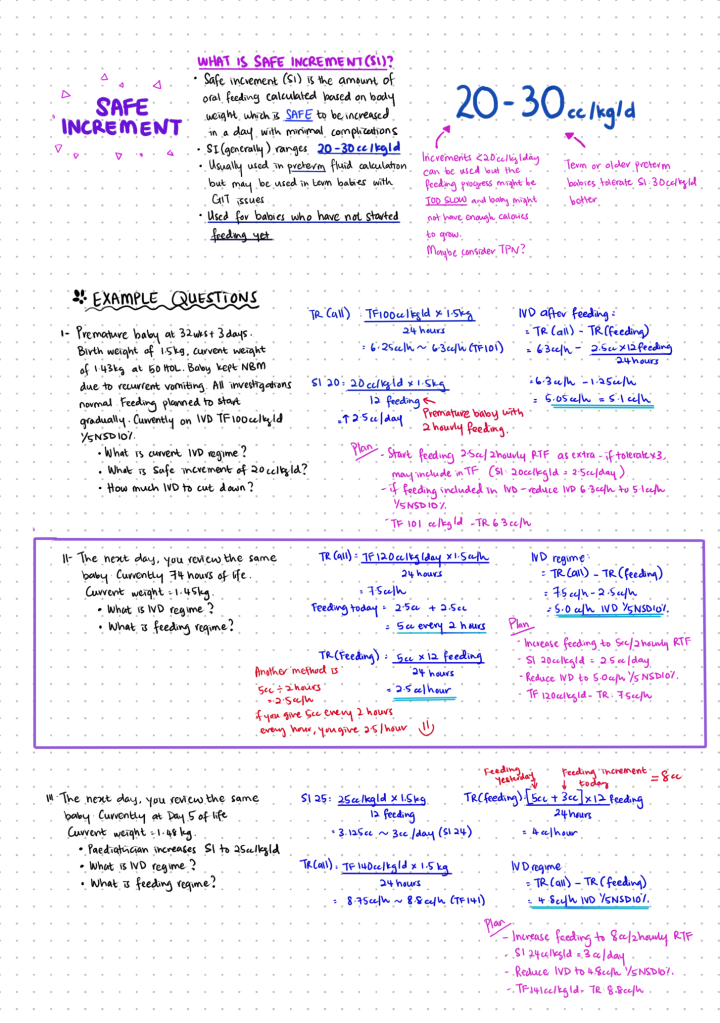This time we’ll talk about infusion feeding and safe increments.
Honestly though, I don’t expect house officers to know about safe increments but if they do, then that’s a thumbs up from me. Because I myself was never taught how to calculate safe increments when I was in residency and I only knew how to calculate it when I become a medical officer.
But it certainly helps if you know the concept.


I’m to lazy to write any more questions but I’ll type it here so that you can practice and understand how to calculate in other settings.
- Premature baby at 28 weeks + 2 days. Birth weight of 0.89 kg, current weight: 0.91 kg. Currently at Day 13 of life, corrected age: 30weeks + 0 days. Baby currently on infusion pump feeding: 8 cc/h x3 rest one hour (TF: 158 cc/kg/d). What would be your safe increment for the next day?
- Term baby at 38 weeks +6 days, delivery complicated with HIE and has feeding intolerance during the first 3 days. He is currently at 86 HOL and was plan to start feeding gradually. Birth weight is 3.2 kg. How would you start feeding?
- Premature second twin baby at 31 weeks + 3 days. Birth weight of 1.1 kg current weight of 0.88 kg at Day 5 of life. Bolus 2 hourly feeding during the early neonatal period was wrought with feeding intolerance. Plan to start infusion pump feeding with SI of 20 cc/kg/d. How long would it take to achieve full feeding of TF 120 cc/kg/d?
- Using the same patient from Question (3), it was decided that the feeding will be increased by 1.5 cc every day. Is this feeding considered safe? With a feeding of 1.5 cc/day, how long would it take for the baby to achieve full feeding?
Answer for Question (1): use current weight of 0.91 kg
- Safe increment 20cc/kg/d = 20cc/kg/dx0.91kg/18 feeding = 1 cc/day
- Increase feeding to 9cc/h x3 rest one hour of infusion pump feeding tomorrow (TF: 178 cc/kg/day)
- If plan for a higher SI, then SI 25cc/kg/d =
- SI 25cc/kg/d = 1.26cc/day ~ 1.2 cc/day = SI = 23.7 cc/day.
- Hence, feeding tomorrow would be: 9.2 cc/h x3,rest one hour = 182 cc/kg/day)
- If plan for maximum SI, then SI 30 cc/kg/d =
- SI 30cc/kg/d = 1.51 cc/d ~ 1.5cc/d
- Hence feeding tomorrow would be 9.5 cc/h x3, rest one hour = 188 cc/kg/day)
Answer for Question (2) – Use birth weight of 3.2 kg
- TF at 86 hours of life (Day 4) = TF 150 cc/kg/d (TR = 20 cc/h)
- SI 20 cc/kg/d = 20cc/kg/d x3.2 kg /8 feeding = 8 cc/day
- Plan: Start feeding 8 cc/3 hourly as extra. If tolerate x3, may include in total fluid (TF).
- If include in total fluid, cut down IVD from 20cc/h to 17.3 cc/h 1/5NSD10%
- If plan for a higher SI, then SI 25cc/kg/d =
- SI 25cc/kg/d = 10cc/day
- Start feeding 10 cc/3 hourly as extra. If tolerate x3, may include in total fluid (TF).
- If include in total fluid, cut down IVD from 20cc/h to 16.7 cc/h 1/5NSD10%
- If plan for maximum SI, then SI 30 cc/kg/d =
- SI 30cc/kg/d = 12cc/d
- Start feeding 12 cc/3 hourly as extra. If tolerate x3, may include in total fluid (TF).
- If include in total fluid, cut down IVD from 20cc/h to 16 cc/h 1/5NSD10%
Answer for Question (3) – Use birth weight of 1.1 kg
- SI 20cc/kg/d = 1.22cc/day ~ 1.2 cc/d
- TF: 120cc/kg/day (full feeding) = 7.3 cc/hx3 rest one hour
- How many days = 7.3 cc/h divided by 1.2 cc/day = 6.1 days
- It will take 6.1 days for baby to achieve full feeding to TF 120 cc/kg/d
- So in the meantime, you might want to consider inserting PICC for TPN
Answer for Question (4) – Use birth weight of 1.1 kg
- 1.5cc/day x18 feedings / 1.1 kg = SI: 24.5 cc/kg/day
- Yes, it falls within the range of 20 – 30 cc/kg/d – it is considered SAFE
- TF: 120cc/kg/day (full feeding) = 7.3 cc/hx3 rest one hour
- How many days = 7.3 cc / 1.5 cc = 4.9 days ~ 5 days
- It will take roughly ~ 5 days for baby to achieve full feeding to TF 120 cc/kg/d
Again: different centres employ different protocols. Some centres use a range of 15 – 30 cc/kg/day for safe increment, some even go as high as 40 cc/kg/d. It depends on the practice.
Also, in the centre which I used to practice, a feeding of TF 120 cc/kg/d is considered full feeding. Which means, at this amount of milk, the baby is unlikely to get hypoglycemia, so you don’t need to top off the remaining 30cc/kg/d with intravenous fluid. Because placing a baby on intravenous fluid requires canulation for IV access, you will need to poke the baby just for fluids (which will only be used for one day give or take) which is painful and stressful to them! And what are the chances that you can get access with a single attempt? We try to minimize blood taking and line setting as much as possible in babies and children.
In fact, again, in the centre where I used to practice, if the IV line is not working, even at a TF of 100cc/kg/day, we would not recanulate (unless baby requires a line for antibiotics or other medications) but we will prefer to check the serum glucose regularly because it is less painful then attempting cannulation. This is provided that the baby has no previous issues with sugar control.
Again, and I stress it again: Follow your hospital’s protocol.
The fun starts when we begin calculating total parenteral nutrition (TPN).
*Rubs hands menacingly*